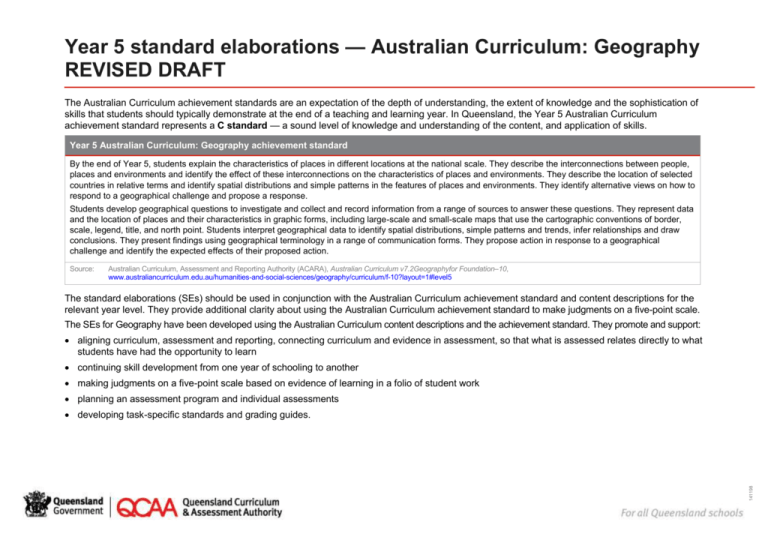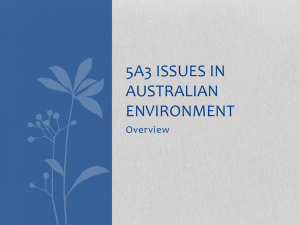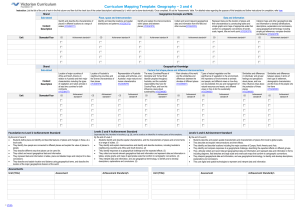Year 5 Geography standard elaborations (DOCX, 108 kB )
advertisement

Year 5 standard elaborations — Australian Curriculum: Geography REVISED DRAFT The Australian Curriculum achievement standards are an expectation of the depth of understanding, the extent of knowledge and the sophistication of skills that students should typically demonstrate at the end of a teaching and learning year. In Queensland, the Year 5 Australian Curriculum achievement standard represents a C standard — a sound level of knowledge and understanding of the content, and application of skills. Year 5 Australian Curriculum: Geography achievement standard By the end of Year 5, students explain the characteristics of places in different locations at the national scale. They describe the interconnections between people, places and environments and identify the effect of these interconnections on the characteristics of places and environments. They describe the location of selected countries in relative terms and identify spatial distributions and simple patterns in the features of places and environments. They identify alternative views on how to respond to a geographical challenge and propose a response. Students develop geographical questions to investigate and collect and record information from a range of sources to answer these questions. They represent data and the location of places and their characteristics in graphic forms, including large-scale and small-scale maps that use the cartographic conventions of border, scale, legend, title, and north point. Students interpret geographical data to identify spatial distributions, simple patterns and trends, infer relationships and draw conclusions. They present findings using geographical terminology in a range of communication forms. They propose action in response to a geographical challenge and identify the expected effects of their proposed action. Source: Australian Curriculum, Assessment and Reporting Authority (ACARA), Australian Curriculum v7.2Geographyfor Foundation–10, www.australiancurriculum.edu.au/humanities-and-social-sciences/geography/curriculum/f-10?layout=1#level5 The standard elaborations (SEs) should be used in conjunction with the Australian Curriculum achievement standard and content descriptions for the relevant year level. They provide additional clarity about using the Australian Curriculum achievement standard to make judgments on a five-point scale. The SEs for Geography have been developed using the Australian Curriculum content descriptions and the achievement standard. They promote and support: aligning curriculum, assessment and reporting, connecting curriculum and evidence in assessment, so that what is assessed relates directly to what students have had the opportunity to learn continuing skill development from one year of schooling to another making judgments on a five-point scale based on evidence of learning in a folio of student work planning an assessment program and individual assessments 141198 developing task-specific standards and grading guides. Year 5 Geography standard elaborations A B REVISED DRAFT C D E Geographical knowledge and understanding Understanding and skills dimensions The folio of student work has the following characteristics: comprehensive explanation of the characteristics of places in different locations at the national scale detailed explanation of the characteristics of places in different locations at the national scale explanation of the characteristics of places in different locations at the national scale description of aspects of the characteristics of places in different locations at the national scale statements about the characteristics of places in different locations comprehensive description of interconnections between people, places and environments and identification and explanation of the effect of these interconnections on the characteristics of places and environments detailed description of interconnections between people, places and environments and identification and description of the effect of these interconnections on the characteristics of places and environments description of interconnections between people, places and environments and identification of the effect of these interconnections on the characteristics of places and environments description of aspects of interconnections between people, places and environments and identification of aspects of the effect of these interconnections on the characteristics of places and environments statements about people, places and environments and the effect of these interconnections comprehensive description of the location of selected countries in relative terms and identification and explanation of spatial distributions and patterns in the features of places and environments detailed description of the location of selected countries in relative terms and identification and description of spatial distributions and patterns in the features of places and environments description of the location of selected countries in relative terms and identification of spatial distributions and patterns in the features of places and environments description of the location of selected countries and identification of aspects of spatial distributions and patterns in the features of places and environments identification of the location of selected countries and statements about patterns in the features of places and environments identification and explanation of alternative views on how to respond to a geographical challenge identification and description of alternative views on how to respond to a geographical challenge identification of alternative views on how to respond to a geographical challenge identification of aspects of alternative views on how to respond to a geographical challenge statements about views on how to respond to a geographical challenge Year 5 standard elaborations — Australian Curriculum: Geography REVISED DRAFT Queensland Curriculum & Assessment Authority January 2015 Page 2 of 5 A B C D E Key Interpreting and analysing Understanding and skills dimensions Questioning and researching The folio of student work has the following characteristics: development of geographical questions for investigation and collection, recording and considered use of information from a range of sources to effectively answer these questions development of geographical questions for investigation and collection, recording and informed use of information from a range of sources to effectively answer these questions development of geographical questions for investigation and collection, recording and use of information from a range of sources to answer these questions development of geographical questions for investigation and collection, recording and use of information from sources to answer aspects of these questions use of geographical questions and recording of information from sources interpretation of geographical data to identify and explain spatial distributions, simple patterns and trends, infer relationships and draw reasoned conclusions interpretation of geographical data to identify and compare spatial distributions, simple patterns and trends, infer relationships and draw informed conclusions interpretation of geographical data to identify spatial distributions, simple patterns and trends, infer relationships and draw conclusions interpretation of geographical data to identify aspects of spatial distributions, simple patterns and trends, infer relationships and draw partial conclusions use of data to make statements reasoned proposal of an action in response to a geographical challenge and identification and explanation of the expected effects of the proposed action informed proposal of an action in response to a geographical challenge and identification and description of the expected effects of the proposed action proposal of action in response to a geographical challenge and identification of the expected effects of the proposed action identification of an action in response to a geographical challenge and identification of aspects of the expected effects of the proposed action statements about actions in response to a geographical challenge and expected effects purposeful presentation of findings in a range of communication forms using relevant geographical terminology. effective presentation of findings in a range of communication forms using relevant geographical terminology. presentation of findings in a range of communication forms using geographical terminology. partial presentation of findings in a range of communication forms using everyday language. fragmented presentation of findings in a range of communication forms using everyday language. Shading emphasises the key aspects of the achievement standard and qualities that discriminate between the A–E descriptors. Key terms are described overleaf. Year 5 standard elaborations — Australian Curriculum: Geography REVISED DRAFT Queensland Curriculum & Assessment Authority January 2015 Page 3 of 5 Notes Australian Curriculum common dimensions The SEs describe the qualities of achievement in the two dimensions common to all Australian Curriculum learning area achievement standards — understanding and skills. Dimension Description understanding the concepts underpinning and connecting knowledge in a learning area, related to a student’s ability to appropriately select and apply knowledge to solve problems in that learning area skills the specific techniques, strategies and processes in a learning area Terms used in Year 5 Geography SEs The following terms are used in the Year 5 Geography SEs. They help to clarify the descriptors, and should be read in conjunction with the ACARA Geography glossary: www.australiancurriculum.edu.au/humanities-and-social-sciences/geography/glossary. Term Description accurate consistent with a standard, rule, convention or known facts aspects particular parts or features cartographic conventions the elements on a map that are represented by symbols agreed upon by convention such as scale, north point, legend, and compass direction characteristics of places the geographical characteristics of places include people, climate, production, landforms, built elements of the environment, soils, vegetation, communities, water resources, cultures, mineral resources and landscape comparison; compare estimate, measure or note how things are similar or dissimilar comprehensive detailed and thorough, including all that is relevant considered thought about deliberately with a purpose data information that is directly recorded; it can be quantitative or qualitative description; describe give an account of characteristics or features detail; detailed meticulous; including many of the parts development; develop elaborate or expand in detail; to create or construct effective; effectively capably meets the described requirements explanation; explain provide additional information that demonstrates understanding of reasoning and/or application findings a summary of information gathered through a series of investigations fragmented disjointed, incomplete or isolated Year 5 standard elaborations — Australian Curriculum: Geography REVISED DRAFT Queensland Curriculum & Assessment Authority January 2015 Page 4 of 5 Term Description identification; identify establish or indicate who or what someone or something is infer a conclusion reached on the basis of evidence or reasoning informed having relevant knowledge; being conversant with the topic interconnection the way that people and/or geographical phenomena are connected to each other through environmental processes and human activity partial attempted; incomplete evidence provided pattern regularity in data portrayed in graphs or maps (e.g. the decline in population density, rainfall in Australia with increasing distance from the coast) place place refers to parts of the Earth’s surface and can be described by location, shape, boundaries, features and environmental and human characteristics proposal a plan or solution in response to a situation purposeful intentional; done by design; focused and clearly linked to the goals of the task range covers the scope of relevant situations or elements reasoned logical and sound; presented with justification relevant having some logical connection with scale scale refers to the different spatial levels used to investigate phenomena or represent phenomena visually simple involving few elements, components or steps; obvious data or outcomes source any written or non-written material that can be used in an investigation; in geography, source material includes data and information collected from field work spatial distribution the arrangement of particular phenomena or activities across the surface of the Earth statement a sentence or assertion use of to operate or put into effect Year 5 standard elaborations — Australian Curriculum: Geography REVISED DRAFT Queensland Curriculum & Assessment Authority January 2015 Page 5 of 5








